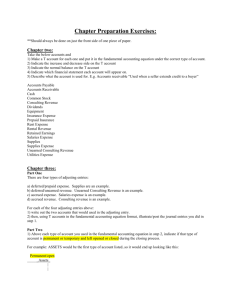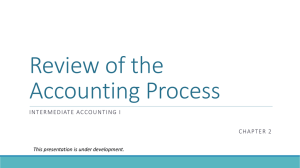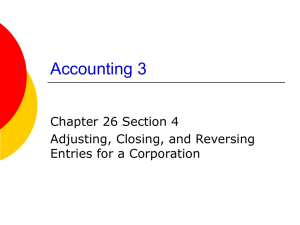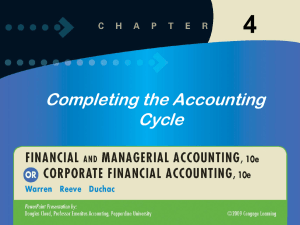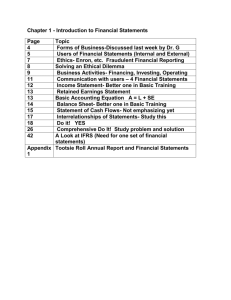Journal
advertisement
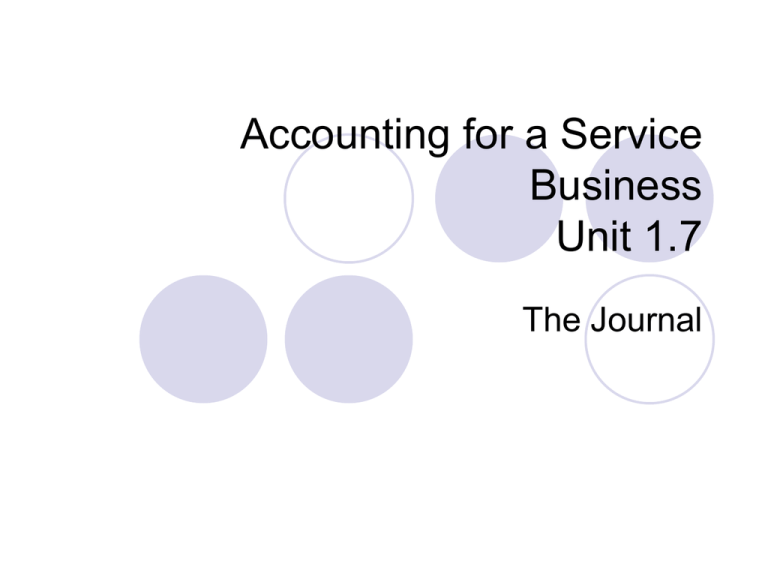
Accounting for a Service Business Unit 1.7 The Journal The Journal All business transactions are first recorded in a journal. The journal is a chronological record of the business’s business transactions. The process of recording transactions in a journal (making journal entries) is called journalizing. The Journal Page 110 of your text shows you a sample general journal. Notice: how the date is set up how the debit is listed first and is flush with the left-hand margin how the credit it listed second and is indented several spaces the explanation following the entry - don’t leave anything up to your memory how we skip a space between journal entries: this lends itself to readability the reference column. We will refer to this later. The Journal What is the difference between a compound entry and a simple entry? A simple entry has only one account debited and one account credited. A compound entry has one or more accounts debited and one or more accounts credited. Journal Entries Peg deposits $15,000 in a bank account in the name of Kline Consulting (KC) Cash (an asset) will increase, therefore a debit Capital (capital account) will increase, a credit Nov. 1 Cash 15,000 Kline, Capital 15,000 (owner’s investment of cash in the business) Journal Entries Peg buys equipment for $10,000 cash to operate her business. Equipment (an asset) will increase…debit Cash (an asset) will decrease…credit Nov.2 Equipment 10,000 Cash 10,000 (purchase of equipment for cash) Journal Entries Peg buys supplies for $1,350, agreeing to pay the supplier in the near future. Supplies (an asset) will increase…debit Accounts Payable (a liability) will increase…credit Nov.3Supplies 1,350 Accounts Payable 1,350 (purchase of supplies on account) Journal Entries KC earns fees of $7,500 and receives the amount in cash. Cash (an asset) will increase…debit Fees Earned (a revenue) will increase…credit Nov.4Cash 7,500 Fees Earned 7,500 (received cash for services provided) Journal Entries KC receives a bill for $300 for advertising. KC will pay this bill at a later date. Advertising Expense (an expense) will increase Accounts Payable (a liability) will increase Nov. 5 Advertising Expense 300 Accounts Payable (purchased advertising on account) 300 Journal Entries KC earns fees of $12,000. KC receives 4,000 in cash and 8,000 is billed to customers on account. Cash(an asset) will increase Accounts receivable (an asset) will increase Fees Earned (revenue) will increase Nov. 6 Cash 4,000 Accounts Receivable 8,000 Fees Earned 12,000 (customer paid cash and account receivable for services provided) Journal Entries KC pays expenses of $500 for rent, $200 for insurance, and $175 for utilities. Rent expense, insurance expense, and utilities expense (all expenses) will increase Cash (an asset) will decrease Nov. 7 Rent Expense Insurance Expense Utilities Expense Cash (paid monthly expenses) 500 200 175 875 Journal Entries KC pays it advertising bill of $1,350 in cash. Accounts Payable (a liability) will decrease Cash (an asset) will decrease Nov. 8 Accounts Payable 1,350 Cash 1,350 (made a payment on account) Journal Entries KC receives $1,750 cash from customers on account. Cash (an asset) will increase Accounts Receivable (an asset) will decrease Nov.9Cash 1,750 Accounts Receivable 1,750 (received payment from a customer on account) Journal Entries Peg Kline withdraws $1,500 in cash from the business for her personal use. Owner’s withdrawals (drawing) will increase…debit Cash (an asset) will decrease…credit 10 Kline, Drawing 1,500 Cash 1,500 (withdrew cash for personal use)
